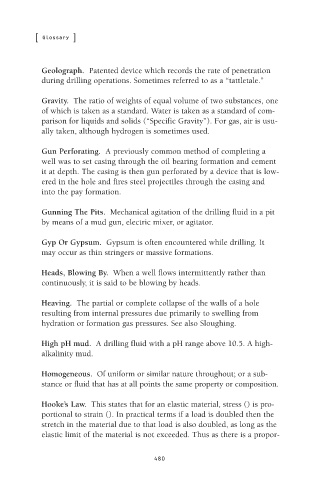Page 504 - Practical Well Planning and Drilling Manual
P. 504
Appendix NEW! revised 11/00/bc 1/30/01 3:30 PM Page 480
[ ]
Glossary
Geolograph. Patented device which records the rate of penetration
during drilling operations. Sometimes referred to as a “tattletale.”
Gravity. The ratio of weights of equal volume of two substances, one
of which is taken as a standard. Water is taken as a standard of com-
parison for liquids and solids (“Specific Gravity”). For gas, air is usu-
ally taken, although hydrogen is sometimes used.
Gun Perforating. A previously common method of completing a
well was to set casing through the oil bearing formation and cement
it at depth. The casing is then gun perforated by a device that is low-
ered in the hole and fires steel projectiles through the casing and
into the pay formation.
Gunning The Pits. Mechanical agitation of the drilling fluid in a pit
by means of a mud gun, electric mixer, or agitator.
Gyp Or Gypsum. Gypsum is often encountered while drilling. It
may occur as thin stringers or massive formations.
Heads, Blowing By. When a well flows intermittently rather than
continuously, it is said to be blowing by heads.
Heaving. The partial or complete collapse of the walls of a hole
resulting from internal pressures due primarily to swelling from
hydration or formation gas pressures. See also Sloughing.
High pH mud. A drilling fluid with a pH range above 10.5. A high-
alkalinity mud.
Homogeneous. Of uniform or similar nature throughout; or a sub-
stance or fluid that has at all points the same property or composition.
Hooke’s Law. This states that for an elastic material, stress () is pro-
portional to strain (). In practical terms if a load is doubled then the
stretch in the material due to that load is also doubled, as long as the
elastic limit of the material is not exceeded. Thus as there is a propor-
480

